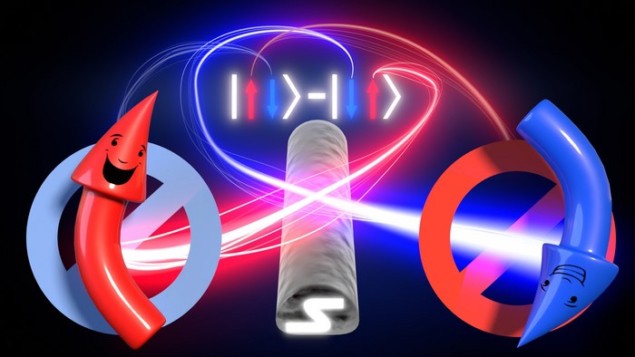
An experiment has shown that the spins of two electrons in a Cooper pair have a negative correlation – that they tend to point in opposite directions as predicted by the quantum theory of superconductivity. The observation was made by physicists in Switzerland and Italy and is claimed to be the first experimental confirmation of this effect.
Led by Arunav Bordoloi at the University of Basel, the team measured the spin correlation using a new spin-filter setup, which uses two quantum dots to extract Cooper pairs from a tiny piece of superconductor.
In the conventional description of superconductivity, electrons form Cooper pairs below a critical temperature. Unlike individual electrons, the pairs obey Bose–Einstein statistics and can therefore condense to form a collective superconducting state in which the charge-carrying electrons can flow without resistance.
Negative correlation
In a conventional superconductor, Cooper pairs have zero spin. This means that the two constituent electrons have individual spins pointing in opposite directions. This negative correlation between the spins is an example of quantum entanglement, whereby the relationship between the particles is stronger than that allowed in classical physics.
Entangled particles play important roles in quantum technologies such as computing and sensing, and the ability to extract negatively correlated entangled pairs of electrons from a superconductor could lead to the development of new quantum technologies.
For several years now, Bordoloi and colleagues have been able to extract Cooper pairs from a superconductor and separate them. Until now, however, they had not been able to show that the spins of the electrons are negatively correlated.
Bordoloi’s team observed this negative correlation by building a new experiment that can filter individual electrons according to their spins. Like their previous experiments, the set-up comprises a small piece of superconductor that is sandwiched between two quantum dots.
Spin filters
By adjusting the electric and magnetic fields applied to the system, a Cooper pair in the superconductor can be split. The constituent electrons then go their separate ways into the two different quantum dots and then into two normal conductors. Using tiny magnets, each quantum dot can be made to operate as a spin filter that only allows electrons with a specific spin orientation to pass though. By setting the filters in opposite directions, the set-up should only be able to extract Cooper pairs with electron spins that are negatively correlated. Likewise, if the filters are set in the same direction, then only Cooper pairs with positively correlated spins will be extracted.

Graphene quantum dots split Cooper pairs
As predicted by theory, the current of Cooper pairs extracted from the superconductor was greatest when the spin filters were set in the opposite direction – and the lowest current was observed when the spin filters were set in the same direction. However, the team did not see a perfect negative correlation because quantum-tunnelling effects reduced the ability of the quantum dots to operate as spin filters. Also, the experiment is not a complete observation of the negative correlation because the filters only operate in one direction.
Bordoloi and colleagues are hopeful that their new technique will be used to study a wide variety of spin correlations in solids. As well as boosting our understand of phenomena such as superconductivity and magnetism, the method could be used to develop new spin-based quantum technologies such as magnetic sensors.
The research is reported in Nature.



